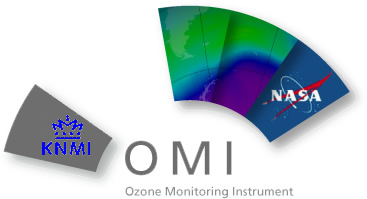
OMI

The Ozone Monitoring Instrument (OMI) is a nadir-viewing, wide-field-imaging UV and visible spectrometer designed to monitor ozone and other atmospheric species including aerosols. It is the key instrument on EOS AURA for monitoring the recovery of the ozone layer in response to the phase out of chemicals, such as CFCs. OMI will measure key atmospheric pollutants identified by the U.S. Environmental Protection Agency as posing serious threats to human health and agricultural productivity: O3, NO2, SO2 and aerosols. OMI effectively continues the TOMS record for total ozone measurements. It is a contribution of the Netherland's agency for aerospace programs (NIVR) and also of Finland's Finnish Meteorological Institute (FMI) to the EOS AURA mission.
Objectives
OMI is the key instrument on EOS Aura for monitoring the recovery of the ozone layer in response to the phase out of chemicals, such as CFCs, agreed to by the nations of the world in the Montreal protocol and later modifications to it at Copenhagen, and London.
- Continue the long-term monitoring of global total ozone trends from satellite measurements that began in 1970 with BUV on Nimbus-4
- Map ozone profiles at 36 x 48 km, a spatial resolution never achieved before.
- Measure key air quality components such as NO2, SO2, BrO, OClO, and aerosol char.
- Distinguish between aerosol types, such as smoke, dust, and sulfates.
- Measure cloud pressure and coverage, which provide data to derive tropospheric ozone.
- Map global distribution and trends in UV-B radiation.
Instrument
The instrument observes Earth's backscattered radiation with a wide-field telescope feeding two imaging grating spectrometers. Each spectrometer employs a CCD detector.Onboard calibration includes a white light source, LEDs, and a multi-surface solar-calibration diffuser. A depolarizer removes the polarization from the backscattered radiation.
The instrument is a contribution of the Netherlands's Agency for Aerospace Programs (NIVR) in collaboration with the Finnish Meteorological Institute (FMI) to the EOS Aura mission.
Instrument Specifications:
| Instrument Type | Pushbroom type imaging grating spectrometer |
| Heritage | TOMS, SBUV, GOME, SCIAMACHY, GOMOS |
| Spectral Resolution | 1.0 - 0.45 nm FWHM |
| Spectral Sampling | 2-3 for FWHM |
| Detector | CCD: 780 x 576 (spectral x spatial) pixels |
| Field of View (FOV) | 114 degrees (2600 km on ground) |
| Instrument Instantaneous FOV | 3 km binned to 13 x 24 km |
| Band | Wavelength (µm) | Resolution (m) | Swath Width (km) |
|---|---|---|---|
| Band UV-1 (UV) | 0.27 to 0.14 | 13000 (24000) | 2600 |
| Band UV-2 (UV) | 0.306 to 0.38 | ||
| Band VIS (VIS) | 0.35 to 0.5 | 13000 (12000) | 2600 (750) |
Data Access
General Data Product Level DefinitionImportant Information for OMI Data Users in light of the current data quality problem with row anomalies.
A combination of algorithms including TOMS version 7, Differential Optical Absorption Spectroscopy (DOAS), Hyperspectral BUV Retrievals and forward modeling will be used together to extract the various OMI data products. The GSFC Earth Sciences (GES) Data and Information Services Center (DISC) will archive and distribute the Level 1, Level 2 and Level 3 OMI products. The GES DISC provides users with their own tool for searching and ordering data sets. (The GES DISC data search interface).
To acquire OMI data (Level 1, 2 and 3) please visit either the GES DISC Mirador Search Interface
or theEOS Warehouse Inventory Search Tool.
TEMIS: OMI
tropospheric NO2 data archive
The Aura Platform
The Aura spacecraft was successfully launched on July 15, 2004 aboard a Delta II 7920-10L, a two stage expendable rocket, from the Vandenberg Western Test Range. The mission hosts a suite of scientific instruments designed to make the most comprehensive measurements ever undertaken of trace gases in the environment that surrounds earth. The satellite's orbit will allow measurements to be taken at all latitudes; instruments will make continuous scans at altitudes ranging from the stratosphere down through the troposphere. EOS Aura is the third in a series of major Earth observing satellites to study the environment and climate change and is part of NASA's Earth Science Enterprise. The first and second missions, Terra and Aqua, are designed to study the land, oceans, and the Earth's radiation budget.
The satellite carries four state-of-the-art instruments:
- High Resolution Dynamics Limb Sounder (HIRDLS)
- Microwave Limb Sounder (MLS)
- Ozone Monitoring Instrument (OMI)
- Tropospheric Emission Spectrometer (TES)
Contact
If you would like to have more information about the OMI data, please contact wdc@dlr.de.